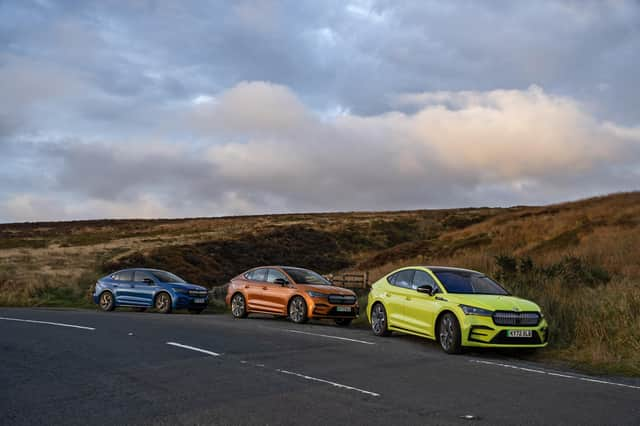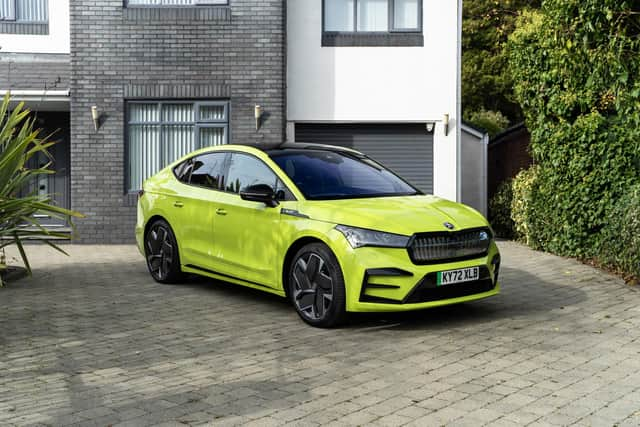Skoda: Proof that electric vehicles can be fun and sporty


Yet it has just the one gear and no engine at all. Rather, power is from a pair of electric motors which silently embarrasses big-name German rivals.
There is no thunder of cylinders, only a whoosh of tyre on tarmac. But this car carries a proud sporting badge (vRS). It could also carry five people and a load of luggage, too.
Advertisement
Hide AdAdvertisement
Hide AdThis car is more than just one vehicle: it is a hot-hatch, combined with a people-carrier and a dash of estate.


Like many modern electric vehicles, you might struggle to identify the brand. The almost-kidney grille might have echoes of BMW but it is in fact a Skoda.
That’s right, Skoda. Not a problem to anyone under 40 but to grey-haired types the brand might come with baggage. Worry not. Skoda of 2023 is a different beast to Skoda of 1983, when our neighbour had a hearing aid beige. He was proud of it but it was the butt of unkind jokes.
The only baggage Skodas come with these days can easily be accommodated in the orchestral hall-sized boot.
Advertisement
Hide AdAdvertisement
Hide AdThe price might raise an eyebrow: £55,000. But who pays for cars up front? About as many people as buy mobile phones up front. Leasing is the way for 99 per cent of us, and this can be yours for £580 a month over four years with a 10,874 deposit.
So, how does the Enyaq Coupe stack up? Well, it’s not really a coupe, not in my book anyway. It has five doors which make it a hatchback. Coupes, according my dictionary, comprise two doors, a fixed roof and a sloping rear.
But let’s not argue about definitions. As a car, it feels, rides and handles like a coupe – albeit a big one.
At first it feels like a big bulky people-carrier but with comfortable seats and an accomplished dashboard dominated by a huge laptop-sized screen which is ever so easy to navigate. Like some hi-tech cars these days, you don’t actually start the car. Just push it into gear, and you’re away. You don’t switch if off, either. Just put it into neutral and get out, which is a strange feeling. It’s like walking away from a running car.
Enyaq vRS is designed to sit at the very top of the range.
Advertisement
Hide AdAdvertisement
Hide AdAnd in typical vRS fashion, the external changes aren’t all that dramatic. Yes, it comes with Skoda’s ‘look-at-me’ Crystal Face – which incorporates LED bars into the front grille – but there aren’t too many aesthetic tweaks to differentiate it from the standard Enyaq. It’s subtle, even by vRS standards – there aren’t even any sporty badges on the boot, which is something we feel most buyers would want.
Though the regular Enyaq iV can be equipped with a variety of motor and battery setups, the vRS gets just one. Its 295bhp twin-motor setup makes it the most powerful Skoda on sale today and results in a 0-60mph time of 6.4 seconds. It’s around 35bhp more than you’ll get in the next most-powerful Enyaq and brings a 0.6 second saving off the 0-60mph time, too.
In terms of range, Skoda says that the Enyaq vRS’s 77kWh battery will bring a range of up to 321 miles, while the ability to charge at speeds of up to 135kW (the same as the standard Enyaq) means that a 0-80 per cent charge could be completed in around 35 minutes at a rapid charger. You’re looking at around 13 hours for a 0 to 100 per cent charge at a 7.2kW home wallbox, too.
Skoda’s vRS models traditionally differentiate themselves from the rest of the range through their heightened performance and sharper handling.
Advertisement
Hide AdAdvertisement
Hide AdAs mentioned, the ‘Crystal Face’ comes fitted as standard – and it’s definitely a talking point – with its 131 individual LEDs giving the front of the car a futuristic feel. All cars get 20-inch alloy wheels as standard, though you can upgrade them to 21s should you want. It seems odd to have no rear vRS badging, though, and it could’ve even been integrated into Skoda’s iV electric badge too.
The car’s best style is found inside. You can get the Enyaq vRS in one of two interior specifications – Lounge and Suite. The former brings black Alcantara and lime-coloured piping, while Design has a more traditional focus with black perforated leather seats and grey contrast stitching.
Prices for the Enyaq vRS start from £52,670, which interestingly is only £905 more than the next most-expensive ‘regular’ version – the 80x Sportline Plus – which also receives a dual-motor setup, but doesn’t have the extra power of the vRS.
So, if you were looking at a Sportline Plus, we’d argue it’d be worth pushing up to the vRS. That Crystal Face is a £2,035 option on the Sportline Plus, too, so if you’re madly keen on having it, then it’d be cheaper just to trump for the vRS.
Advertisement
Hide AdAdvertisement
Hide AdIt has an impressive list of features including eight-speaker stereo, aluminium pedals, blind spot detection, panoramic glass roof, a brilliant satellite navigation system, traffic sign recognition and a sophisticated three-zone climate control system.
Oddly, it has a concealed umbrella – one of Skoda’s quirky features.
Is it a coupe? No, but it will offer plenty of coupe thrills and be a terrific family car at the same time.
Skoda Enyaq Coupe iV vRS
Price: £55,370. Test model with extras cost £55,830
Engine: It has an electric motor with a 299ps output and it is powered by a 77kWh battery via a single-speed gearbox
Performance: Top speed 111mph and 0 to 60mph in 6.4 seconds
Emissions: 0
Range: 323 miles
Warranty: Three years, 60,000 miles
Comment Guidelines
National World encourages reader discussion on our stories. User feedback, insights and back-and-forth exchanges add a rich layer of context to reporting. Please review our Community Guidelines before commenting.